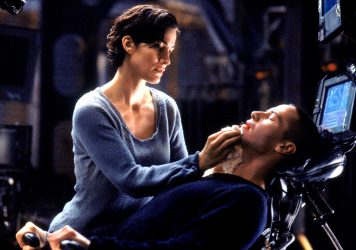This long-awaited sequel is a revolutionary and radical capstone to the Wachowskis’ awe-striking cyberpunk trilogy.
After 22 years, Lana Wachowski returns to the Matrix – a simulation programme designed to deceive humans while their bodies are harvested in amniotic vats for energy. In 1999, Lana and her sister, Lilly, created a cinematic masterpiece that has since evolved and mutated into a branch of philosophy unto itself. From right-wing conspiracists to scholars of trans* theory, the Wachowskis’ authorial hold on The Matrix as a concept has largely slipped away.
A lot has changed for Lana and Lilly in the last two decades. After completing The Matrix trilogy, they co-directed several ever-expanding movie worlds, from Speed Racer to Jupiter Ascending, which felt like an auteurial sandbox for the pair. While they have their fans, most of these subsequent ventures have flopped at the box office and made a Wachowski project a precarious investment. Will their ideas fly and land safely, or will they fall flat on the pavement?
The process of gender transition both Wachowskis underwent during this period has invited reassessment of their early work. Of course, with The Matrix it’s all a matter of perspective – the blue pill thinkers may only just be catching on, but for those of us who took the red pill long before it was cool, the transness of these films has always been self-evident. It’s always been about seeing beyond the binary and unlocking the infinite possibilities offered in that space.
That’s where the fourth film, The Matrix Resurrections, starts off. We live in a blue pill society. Even Neo downs his blockers by the bottleful, shutting out the trauma of diving down the rabbit hole and, like Alice, accepting that it was just a dream. Readopting his dead name, Neo experiences the events of the first three films as flashbacks, receiving Cognitive Behavioural Therapy from his analyst, played by Neil Patrick Harris.
Like many artists, Neo has been projecting these elusive traumas into a video game called The Matrix, something akin to the MMORPG the Wachowskis created after the films to continue the story of Zion. It’s the game that made his name and that everyone knows him for, and after making three instalments, he’s been trying to develop an original game called ‘Binary’ that will take his ideas in a new direction.
These conversations at the start of the film simmer with self-knowing irony. Neo has a meeting with Smith, a version of Hugo Weaving’s arch-nemesis from the original films, now played menacingly by Jonathan Groff. He tells Neo that Warner Bros want him to go back to The Matrix, to develop what the fans want, leading to a montage of developer meetings mocking everything from ‘bullet time’ to guns and philosophical allusions set to the psychedelic soundtrack of ‘White Rabbit’ by Jefferson Airplane.
Coming from any other filmmaker, this could be cringe-inducing. But the Wachowskis are such private individuals, who rarely make any public comment on their personal lives or interpretations of their films, that this feels like a long pent-up final word. It’s hardly surprising that Lilly hasn’t wanted to be a part of this new film – she’s left it in the past, and if Neo’s experience is deliberately evocative of what the Wachowskis have been through, then it’s clearly required a lot of personal strength to dig up their past in this way.

The Matrix Resurrections is a heartbreaking depiction of the damage binary thinking can have, especially on trans* people. But it’s also a beautifully optimistic film which constantly affirms the reality of non-binaryness, and the improvement in quality of life breaking free from our social chains can have. No character is identical in the real world and in the Matrix – every aspect of gender presentation, such as hairstyle and clothing, differs for everyone, a form of switching explored much more explicitly now than it could have been at the turn of the century.
That doesn’t mean the blue-pill thinkers won’t have a great time with The Matrix Resurrections. It’s stunning to watch, a neon-infused matte finish crafted by cinematographers Daniele Massaccesi and John Toll that shows off the improved action choreography and special effects in exciting new ways. And while Hugo Weaving and Laurence Fishburne don’t reprise their roles as Smith and Morpheus (there are a hundred canonical reasons why which there simply isn’t space to delve into here), it’s a nostalgic delight to see Keanu Reeves and Carrie-Anne Moss once again kicking sentinel butt.
But this isn’t a film for them, as much as they like to think the world was created for their benefit. Unlike the eye-rolling fan service of recent franchise reboots like Star Wars or Ghostbusters, no reference is made in The Matrix Resurrections without an essential narrative purpose. It’s such a rich and original tapestry of world expansion that it will no doubt be analysed as intensively as the original films by scholars for years to come. Once the premise is established, and Lana’s had her self-referential fun, buckle your seatbelts for something completely different.
Reeves and Moss are magnificent at resurrecting Neo and Trinity, and they blend exquisitely into Lana Wachowski’s matured style of filmmaking. It’s wonderful to see the influence of her interim projects on this one – David Mitchell, who wrote the novel Cloud Atlas and collaborated on the writing of the Wachowskis’ groundbreaking Netflix series Sense8, assisted with the screenplay along with Aleksandar Hamon. And their Cloud Atlas co-director and composer Tom Tykwer brings a lavish update to Don Davis’s score that heightens the film’s atmosphere at every turn.
Collaboration is an essential part of the Wachowskis’ filmmaking, and while Lilly isn’t present here, this isn’t a lone effort from Lana. There’s a unique warmth that permeates the screen of love for what everyone is doing, and their deep personal investment in this project seldom felt watching a blockbuster. That includes a smattering of Sense8 alumni, as well as Groff and Yahya Abdul-Mateen II who bring refreshing takes on their classic characters.
The Wachowskis love to celebrate newcomers, and Jessica Henwick is sublime as Captain Bugs. Having had a number of small roles in other franchises, her lead turn here keeps The Matrix feeling fresh and alive. The centring of female and non-binary characters in the film feels special and inspires so much hope for the future of cinema. As with all of her work, what Lana Wachowski has achieved in The Matrix Resurrections feels genuinely revolutionary.
Published 22 Dec 2021
Let’s go chase some rabbits…
A film so original and rich you’ll want to swallow another red pill and go again straight away.
The Wachowskis pioneered the modern cinema we know and love – it’s fitting that The Matrix is back to resurrect it.

By Al Horner
The Wachowskis’ 1999 action sci-fi changed blockbuster cinema, altering its code forever.

By Ethan Vestby
The Wachowskis’ pricy paean to juvenilia is a glorious multi-coloured folly which stands in stark contrast to its blockbuster brethren.

Not even Channing Tatum and Mila Kunis are enough to save the Wachowskis’ gnarly, garish space opera.